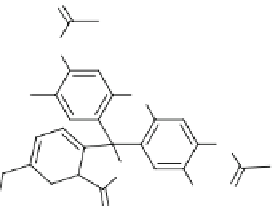Biomedical Engineering Reference
In-Depth Information
Fig. 37
5-Chloromethyl-2¢,
7¢-dichlorodihydrofluorescein
diacetate
O
O
Cl
O
O
O
Cl
O
Cl
O
Fig. 38
Dopamine
NH
2
HO
OH
electrons or in the reaction of positively-charged dopamine radicals with oxygen,
respectively. Anas et al. (
2008
) also found formation of
1
O
2
and that prolonged
photoactivation of a CdSe ZnS QD-plasmid DNA conjugate at 512 nm resulted in
the breakage and damage of DNA. Clarke et al. (
2006
) reported that photoactiva-
tion of QD-dopamine complex internalized in A9 cells results also in DNA damage
due to the production of
1
O
2
(Fig.
38
).
4.2
Silicon Nanoparticles
Silicon nanosystems have been recently shown to be efficient photoluminescence
emitter under light excitation as well as
1
O
2
generator. Two major pathways have
been described for their synthesis. Kovalev's method (Timoshenko et al.
2006
)
consists of obtaining silicon nanocrystals using electrochemical etching of silicon
wafers in a hydrofluoric acid solution. This treatment led to porous silicon layers
which were mechanically milled (ultrasonic bath). The grain size of the powder was
several micrometers but the size of the nanocrystallites in the powder formed from
them was equal to 3-4 nm. The suspension of the powder was prepared in water.
Photoluminescence was observed by excitation at 337 nm. Photoluminescence was
quenched when the suspension was saturated with O
2
indicating transfer to O
2
mol-
ecules. The silicon nanocrystals were then used to treat living mouse fibroblasts.
80% of cancer cells death was observed when a concentration of particles of
2.5 g/L with an irradiation of 1 h using a mercury-vapor light with a glass filter
possessing a pass band of 350-600 nm, demonstrating the efficiency of silicon
particles for PDT applications.


Search WWH ::

Custom Search